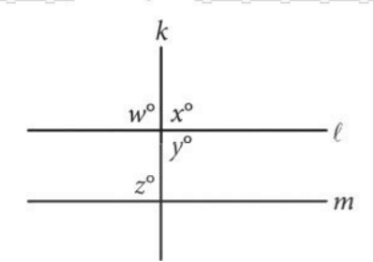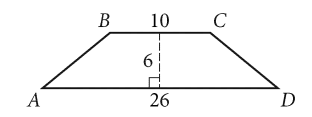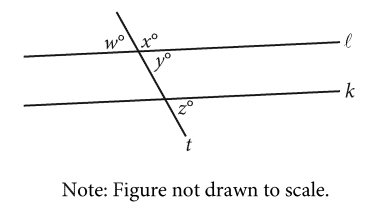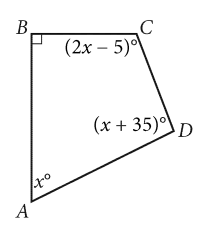Question

In the figure shown, C is the center of the circle and \(\overline{AB}\) is tangent to the circle at A. Which of the following is true about the measure of angle BAC?
- The measure is less than 90°
- The measure is greater than 90°
- The measure is equal to 90°
- It cannot be determined whether the measure is less than, greater than, or equal to 90°
Answer/Explanation
Ans: C
Question

In the figure, lines \(l\) and \(m\) each intersect line \(k\). Which of the following is sufficient to prove that lines \(l\) and \(m\) are parallel?
- \(w\)=\(y\)
- \(w\)=\(z\)
- \(x\)=\(y\)
- \(x\)=\(z\)
Answer/Explanation
Ans: B
Question

In the figure shown, is parallel to
and AB=CD. What is the perimeter of quadrilateral ABCD?
Answer/Explanation
Ans: 56
Question

In the figure shown, line \(t\) intersects lines \(l\) and \(k\). Which additional piece of information is sufficient to prove that lines \(l\) and \(k\) are parallel?
- \(x\) > 90
- \(w\) < 90
- \(w\) = \(y\)
- \(y\) = \(z\)
Answer/Explanation
Ans: D
Question
Rectangle A has an area of 64 square meters. The length and width of rectangle B are 3 times the corresponding length and width of rectangle A. What is the area, in square meters, of rectangle B?
Answer/Explanation
Ans: 576
Question

Quadrilateral ABCD is shown. Which equation shows how the measures of the angles of the quadrilateral are related?
- \(x + 90 + (2x – 5) + (x + 35) = 360\)
- \(4(x+90+(2x-5)+(x+35))=360 \)
- \(x + (2x – 5) + (x + 35) = 360\)
- \(4(x+(2x-5)+(x+35))=360\)
Answer/Explanation
Ans: A
Question
The side length of square \(ABCD\) is twice the side length of square \(EFGH\). If the area of square \(EFGH\) is 9, what is the area of square \(ABCD\) ?
Answer/Explanation
Ans: 36
